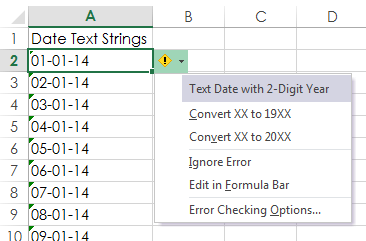- Convert dates stored as text to normal Excel date with formula. Here I will talk about using DateValue function to change the text dates to proper Excel dates. When you input '2013/03/21 into a cell, that apostrophe before the date is used to indicate to Excel that the value in the cell is text value (see following screenshot). You can convert.
- In Excel, you can convert date to other date format in the Format Cells function. Select the dates you want to convert, right click to select Format Cells from context menu.
Excel Dates Displayed in Different Languages. We use the TEXT Function to convert the dates by specifying the language ID in the format argument of the formula. For example: =TEXT('1/1/2017',' $-0809 dddd') =Sunday. Where $-0809 is the language ID for English, and dddd tells Excel to covert the date to the full name of the day. Dates can be awkward in Excel. The most prevalent format worldwide is Day-Month-Year (DMY), but not all countries follow it. One such country you might have heard of that differs from this “standard” is the US, where it is commonplace to use Month-Day-Year (MDY). The other kind of cells (e.g. Rows 10 and below in our example) are not recognized as dates in Excel, because the day (treated as month) is greater than 12 and there is of course no 13th month. For instance, in cell A10 we have the text “1/13/2004” which we want to convert to the date 13 January 2004.
This tutorial shows how to Convert date to Julian format in Excel using example below.
If you need to convert a date to a Julian date format in Excel, you can do so by building a formula that uses the TEXT, YEAR, and DATE functions.
Convert Date In Excel To Day Of Week
Formula
Explanation
Background
“Julian date format” refers to a format where the year value of a date is combined with the “ordinal day for that year” (i.e. 14th day, 100th day, etc.) to form a date stamp.
There are several variations. A date in this format may include a 4-digit year (yyyy) or a two-digit year (yy) and the day number may or may not be padded with zeros to always use 3 digits. For example, for the date January 21, 2017, you might see:
Solution

Convert Dates In Excel From Uk To Us
For a two-digit year + a day number without padding use:

For a two-digit year + a day number padded with zeros to 3 places:
For a four-digit year + a day number padded with zeros to 3 places:
How this formula works
This formula builds the final result in 2 parts, joined by concatenation with the ampersand (&) operator.
On the left of the ampersand, we generate the year value. To extract a 2-digit year, we can use the TEXT function, which can apply a number format inside a formula:
To extract a full year, use the YEAR function:
On the right side of the ampersand we need to figure out the day of year. We do this by subtracting the last day of the previous year from the date we are working with. Because dates are just serial numbers, this will give us the “nth” day of year.
To get the last day of year of the previous year, we use the DATE function. When you give DATE a year and month value, and a zero for day, you get the last day of the previous month. So:
gives us the last day of the previous year, which is December 31, 2015 in the example.
Convert Date In Excel To Number
Now we need to pad the day value with zeros. Again, we can use the TEXT function:
Reverse Julian date
If you need to convert a Julian date back to a regular date, you can use a formula that parses Julian date and runs it through the date function with a month of 1 and day equal to the “nth” day. For example, this would create a date from a yyyyddd Julian date like 1999143.
If you just have a day number (e.g. 100, 153, etc.), you can hard-code the year and insert the day this:
Convert Dates In Excel To Calendar
Where A1 contains the day number. This works because the DATE function knows how to adjust for values that are out of range.